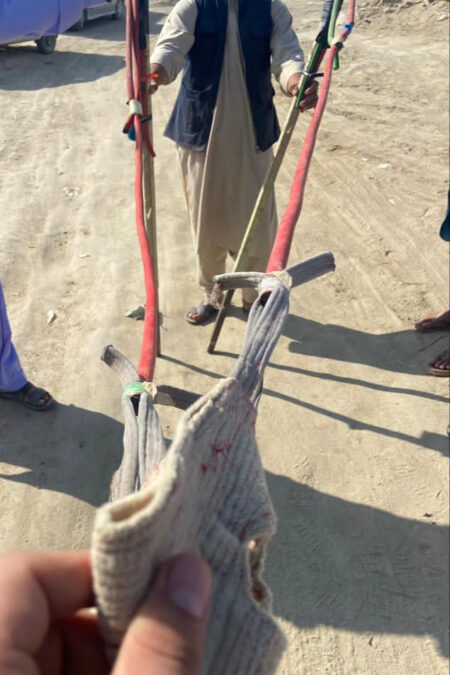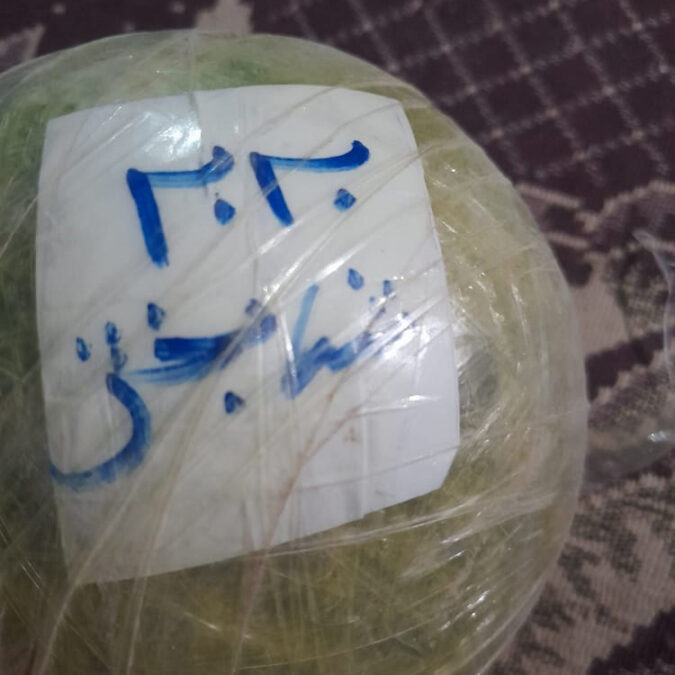The Taliban have officially imposed levies, under the pretext of tax, on drug smugglers in the western province of Nimroz, and appear to support ingenious ways to get drugs into Iran – including by catapult.
Nimroz has always been one of the main drug smuggling routes to Iran and according to a number of drug smugglers, who spoke to Amu TV, drug smuggling is now done “officially” under the Taliban.
Residents and drug smugglers said that since the fall of the republic government and the takeover by the Taliban, the group facilitates drug trafficking in the province, which is the “gateway” to Iran.
Drug smugglers speak out
Ghafoor, a 35-year-old man who traffics narcotics from Nimroz capital, Zaranj city, to the Kang district of the province, told Amu TV that since the Taliban takeover, the whole drug trafficking business has become a lot easier.
He said the Taliban collect taxes, from all vehicles carrying drugs, and that drug traffickers move their consignments to Kang, which borders Iran, without any difficulties.
A resident of Kang district, who wished to remain anonymous, said that once the tax has been paid, the Taliban issued the trafficker with a receipt.

This receipt, called a customs bill by the Taliban, has to be shown before drugs can be sent across to Iran. If this receipt is not shown, the drug traffickers receive a fine, the Kang resident said.
Criticizing the Taliban’s double standard policy on banning the cultivation of poppies and cannabis but supporting the drug smuggling sector, the source told Amu TV: “On one hand, the Taliban destroyed the cannabis farms in some areas, and on the other hand, they impose a tax on the drugs and opium farmers.”
The ‘official’ system
A number of smugglers said that the Taliban collect taxes at two places; first at the loading areas and second at the delivery points where traffickers leave for Iran.
The Taliban charge smugglers 600 Afghanis for every one kg of opium – calling it a tax, one drug smuggler explained.
“300 Afghanis are being collected for internal customs charges and 300 Afghanis are collected as external customs charges. After that the traffickers are allowed to transfer opium abroad,” he said.
“During the Republic, any groups (traffickers) used to pay 50,000 Tomans for one kg of opium to each police checkpoint in the form of a bribe; it was difficult because the (traffickers) would be imprisoned for several years if they were caught with drugs; But now it is much easier; Because they are not afraid of getting caught and going to prison, because they pay taxes for the drugs.”
Ghafoor, another drug trafficker in Nimroz, told Amu TV that in the past they would transport drugs at night, with their car’s lights switched off. But now things are different and it’s a lot easier to move their drugs as they pay their taxes.

However, the price of opium increased, he said, from 3,800 Afghanis to 38,000 Afghanis per kilogram after the Taliban’s supreme leader banned the cultivation of poppies.
Another Kang resident said: “In the past twenty years, traffickers were not able to transfer drugs easily; But now that the Taliban has facilitated the process, only night vision cameras at the Iranian border checkpoints are a challenge for them.”
Taliban says otherwise
Gul Mohammad Qudrat, a spokesman for Nimroz police told Amu TV that the Taliban’s anti-narcotics police department in the province has made an effort to fight drug trafficking. “People who are involved in the buying and distribution of drugs are being arrested every day and they are handed over to judicial entities,” Qudrat said.
Drug “catapults”
Kang residents meanwhile told Amu TV that while the Taliban are facilitating the thriving drug smuggling industry, Iranian officials are a lot harder to get past.
Because of this, drug smugglers have come up with some novel ideas to get their narcotics across the borders. Locals say the drug traffickers use catapults to launch bundles of narcotics into Iranian territory.
One resident said that catapults have been used for this purpose for the past five years.

“At the beginning, this work (smuggling) was easy, because there were no night vision cameras at the Iranian base; But later, cameras were installed and smuggling became more difficult. After that, they (smugglers) thought of transporting drugs through the air; This way poses no threat to the smuggler, and that’s why they made catapults,” he said.
Ghafoor said they get 2,000 Afghanis for every kilogram “with a guarantee of safe arrival” but without a guarantee of safe arrival, they only get 250 Afghanis.
He also said five people are directly involved in the process. The owner of the drugs, the driver who takes the drugs to Kang district, and two people who operate the catapult. The fifth person is on the other side of the border in Iran and collects the catapulted packages.
Ghafoor stated the catapult is key to getting the drugs over the border.
The catapult itself
Sediqullah, who used to operate a catapult said he left the job as he fractured too many ribs in the process.
According to him, the contraption is made of steel, suede, plaster, cement and sacks. The operators dig a trench, and working together, two men reverse down the slope into the trench while pulling the slingshot with them, which has a bag of drugs balanced in the center. Once they have reached a certain point, they let go of the band, which then launches the bag of drugs into the air and over the border.
However, before the drugs are catapulted into Iran, Taliban “customs” labels the packages at the site. Once done, and the drugs have been tossed across into Iran, the traffickers inform their contact on the other side of the border and give him the package’s code for collection.
Sediqullah said when he worked as a catapult operator, he would be in constant contact with his counterpart on the Iranian side. However, there were times when Iranian officials would find the packages.
“Drugs are being thrown by the slingshot at a distance of 200 to 500 meters. On the other side of the border, drugs are placed inside the car and transported to a certain place. The bowman must be well-trained so that drugs are not thrown in an unknown direction and he must specify the route accurately; Otherwise, they have to pay for the drugs,” he added.

According to him, these packages are mostly launched from the canal inside Afghanistan or the canal between Afghanistan and Iran border in Kang district, adding that Iranian border forces will either arrest or shoot smugglers if they find them.
Another source familiar with the matter said that a clash broke out between the Taliban and Iranian forces after the Iranians opened fire on drug smugglers in early December. The skirmishes took place in the village of Shir Ahmad Makaki in Kang district.
According to the source, the Iranian forces opened fire when they spotted traffickers launching drugs into Iran.
Mufti Habibullah Elham, the head of the Taliban’s information and culture directorate in Nimroz province, however, denied reports of border skirmishes and said the shooting had been “mistaken shots” by Iranian forces.
Sources, however, stated that the clashes broke out at around 3pm on December 7 due to drug trafficking.
Taliban officials meanwhile said that 95 people involved in drug dealing have been arrested this year. These drug dealers had however been arrested and punished for selling small amounts of drugs in Zaranj.
Sources say that while the Taliban arrest small-time dealers, they support the smuggling of drugs out of the country.
Drugs under Taliban
In a research paper published last month, the UN Office on Drugs and Crime (UNODC) said that since the takeover by the Taliban in August 2021 a marked increase has been noted in the cultivation of opium and the price of drugs.
UNODC stated the following:
1. Opium cultivation in Afghanistan increased by 32% over the previous year to 233,000 hectares – making the 2022 crop the third largest area under opium cultivation since monitoring began.
2. Opium prices have soared following the announcement of the cultivation ban in April 2022.
3. The income made by farmers from opium sales tripled from USD 425 million in 2021 to $1.4 billion in 2022 – the equivalent of 29% of the 2021 agricultural sector value. The sum still represents only a fraction of the income made from production and trafficking within the country. Increasingly larger sums are further accrued along the illicit drug supply chain outside the country.
4. Seizures of opiates around Afghanistan indicate that the trafficking of Afghan opium and heroin has not stopped. Afghanistan supplies 80% of global opiate demand.





